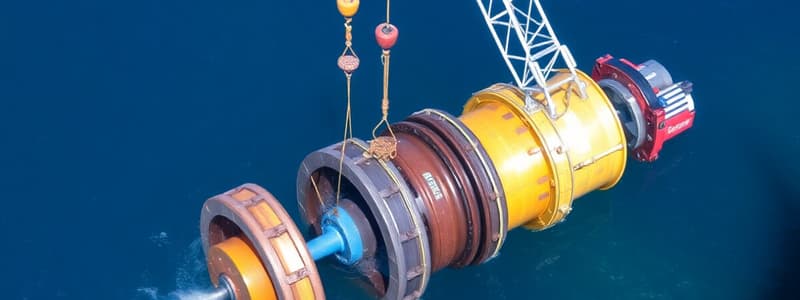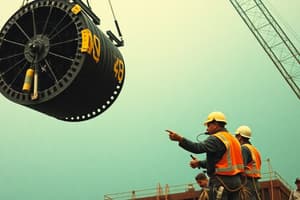Podcast
Questions and Answers
During the subsea spool tie-in operations, what primary factor contributed to the crane hook striking the diver's helmet?
During the subsea spool tie-in operations, what primary factor contributed to the crane hook striking the diver's helmet?
- The crane operator intentionally lowered the hook too quickly.
- The diving supervisor made an incorrect assumption about the hook's position due to a 'no weight' reading. (correct)
- The diver failed to follow the correct procedure for disconnecting the rigging.
- The protective equipment failed to absorb the impact.
Which of the following actions would be MOST effective in preventing a similar incident during future subsea lifting operations in limited visibility conditions?
Which of the following actions would be MOST effective in preventing a similar incident during future subsea lifting operations in limited visibility conditions?
- Increasing the speed at which the crane hook is lowered to reduce operational time.
- Relying solely on verbal communication between the crane operator and the diving supervisor.
- Mandating the use of thicker diving helmets for all subsea operations.
- Using additional locating beacons, underwater cameras, or sonar to track the position of critical equipment. (correct)
In the described incident, what immediate action demonstrated effective emergency response after the diver's helmet was struck?
In the described incident, what immediate action demonstrated effective emergency response after the diver's helmet was struck?
- Diver 2 promptly assisted Diver 1, ensuring that no injuries were sustained, and both divers returned to the bell safely. (correct)
- The diving supervisor immediately blamed the crane operator for the incident.
- The crane operator immediately stopped all operations and refused to continue working.
- The diving supervisor ignored the incident and continued with operations.
What critical factor related to the equipment contributed to the incident of the crane hook striking the diver's helmet?
What critical factor related to the equipment contributed to the incident of the crane hook striking the diver's helmet?
Following the described incident, which of the following actions would BEST address the identified causes to prevent recurrence?
Following the described incident, which of the following actions would BEST address the identified causes to prevent recurrence?
Flashcards
Subsea Crane Hook Incident
Subsea Crane Hook Incident
During subsea spool tie-in operations, a crane hook unexpectedly struck a diver's helmet, resulting in damage to the helmet.
Sequence of Events
Sequence of Events
The crane operator lowered the hook, assuming it reached the seabed. When the diver moved to disconnect rigging, the hook slipped and struck the diver's helmet.
Causes of the Incident
Causes of the Incident
Inadequate crane pennant length and poor visibility hindered the ability to accurately observe the crane hook's position.
Prevention Measures
Prevention Measures
Signup and view all the flashcards
Importance of Clear Communication
Importance of Clear Communication
Signup and view all the flashcards
Study Notes
- During subsea spool tie-in operations, a crane hook unexpectedly struck a diver's helmet.
What Happened
- Divers were working on the seabed in poor visibility during subsea spool tie-in operations.
- After landing the pipe handling frame (PHF) on the seabed, the Diving Supervisor told the crane operator to lower the crane hook to the seabed to disconnect rigging from crane.
- The crane operator reported there was 'no weight' on the crane wire, and the Diving Supervisor assumed the hook had reached the seabed.
- The diver was told to disconnect the PHF from the crane.
- A crane hook unexpectedly struck the diver's helmet while positioned beneath the PHF and moving to disconnect the rigging.
- The diver was unharmed and returned to the dive bell, and the dive was aborted.
- The diver's reclaim helmet was damaged beyond repair, including the side block, but the integrity of the helmet was maintained.
What Went Right
- Diver 2 promptly assisted Diver 1, ensuring that no injuries were sustained, and both divers returned to the bell safely.
- Both divers and the crane block had locating beacons to enable accurate tracking.
- All procedures, lifting plans, and Job Hazard Analysis (JHAs) were followed.
- The diver was uninjured because the impact was absorbed by the helmet.
What Went Wrong
- When the crane hook was lowered for PHF rigging disconnection, it came to rest on the top beam of the PHF.
- The crane operator assumed the hook had reached the seabed because of the 'no weight' reading.
- The hook slipped off the beam and struck the side of the diver's helmet as the diver approached the disconnection point.
What Was the Cause
- There was an inadequate length of crane pennant / stinger, which did not provide sufficient distance between the divers and the crane hook.
- Poor visibility hindered the ability to accurately observe the position of the crane hook.
Lessons and Actions
- Ensure adequate distance between divers and crane hook.
- The length of the crane pennant/stinger should maintain a safe distance between the divers and the crane hook during subsea operations to reduce the risk of accidental contact.
- Use enhanced visibility aids and monitoring.
- In environments with poor visibility, alternative methods such as additional locating beacons, underwater cameras, or sonar should be considered to better track the position of critical equipment like the crane hook.
- Improved monitoring can help prevent misjudgements about the location of the crane hook.
- Reinforce communications, challenge assumptions; assumptions regarding equipment position should be minimised.
- Reinforce clear communication and confirmation procedures between the dive supervisor, crane operator, and divers, to ensure all parties are fully aware of equipment location.
- Updated project procedures now specify minimum pennant lengths for different operations.
- Pre-operation inspections of all rigging and lifting equipment, including crane hooks and pennants are performed to ensure they meet safety standards.
- The Job Hazard Analysis (JHA) was updated to incorporate lessons learned from this incident, particularly regarding safe distances, visibility, and communication requirements for subsea lifting operations.
Studying That Suits You
Use AI to generate personalized quizzes and flashcards to suit your learning preferences.




